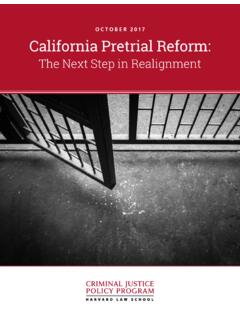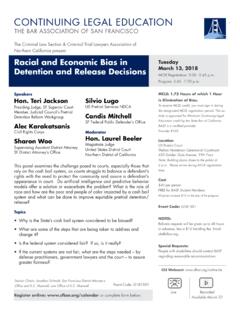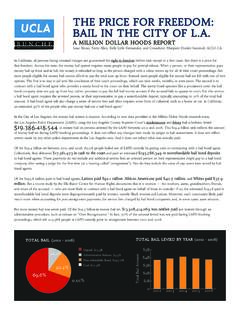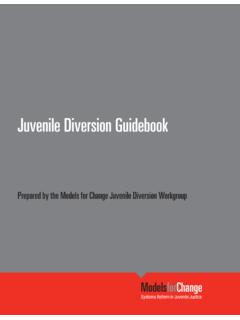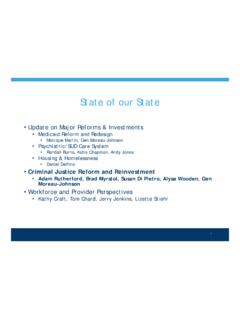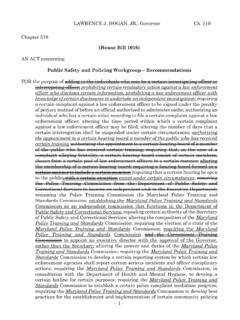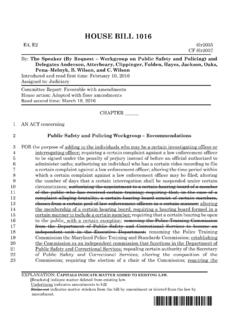Transcription of An Analysis of Racial Disproportionality in Juvenile ...
1 An Analysis of Racial Disproportionality in Juvenile confinement An Analysis of Disproportionate Minority confinement in the Hennepin County Juvenile detention Center August, 2006 Prepared by the Council on Crime and Justice 1 Table of Contents 2 Executive 3 4 Section One: Literature 4 Background 8 Section Two: 9 Limitations of the 10 Section Three: 11 Section Four: Conclusions and 40 44 Appendix A: Hennepin County detention 44 Appendix B: Racial Disparities Steering 48 Appendix C: Disproportionate Minority Contact 49 Appendix D: Data 50 Appendix 57 Appendix 58 Appendix 60 Appendix 63 Appendix 65 Appendix 69 Appendix 70 Appendix 79 Appendix 86 Appendix 87 Appendix 88 Appendix 90 Appendix 91 2 Acknowledgments This report would not have been possible without the help of many people.
2 We thank those who provided electronic data and responded to our numerous questions about the data, including: Justin Bock (Hennepin County Juvenile detention Center), Jerry Driessen (Hennepin County Department of Strategic Initiatives and Community Engagement), Gail Clapp (Hennepin County District Court), Allan Knox (Minneapolis Police Department), Sharon Krumpotich and Wally June (Hennepin County Office of Research and Systems Technology), Jody Murphy (Brooklyn Park Police Department), Rich Sonenblum (LOGIS), and Sarah Welter (Minnesota Supreme Court). Appreciation also goes to Deb Dayon and Michelle Velasco (Hennepin County Juvenile detention Center), and Jan Craig (Hennepin County Department of Strategic Initiatives and Community Engagement) who assisted in our work related to examining individual JDC case files and Gail Clapp and Leana Reese (Hennepin County District Court) who provided necessary MNCIS support and training.
3 Gratitude also goes to Connie Osterbaan (Hennepin County Attorney s Office and Department of Strategic Initiatives and Community Engagement) for providing valuable help and support, particularly in linking JDC admissions to court data. We thank the Disproportionate Minority Contact Work Team and the Juvenile Justice Racial Disparities Committee chaired by Judge Tanya Bransford, all of whom are listed in the body of the report. Finally, we deeply appreciate the contributions of Mary Knudsen (Ericson and Associates) who provided assistance and support for much work throughout the project. Contributors: Becky Ericson Ebony Ruhland Tom Johnson Hilary Whitham Ryan Dailey 3 Executive Summary This study examines the Racial Disproportionality among Juvenile detainees at the Hennepin County Juvenile detention Center (JDC).
4 Data is analyzed from the JDC, from nine police jurisdictions which bring juveniles to the JDC, and census data for 10-17 year olds. Furthermore, cases are followed through the Juvenile court in order to determine the outcome of those cases involving juveniles who were admitted to the JDC. The major findings show that all nine police departments studied refer a disproportionate number of minority juveniles to the JDC. The bulk of the juveniles referred to the JDC are admitted on the basis of a warrant or probation violation stemming from a previous adjudication by the Juvenile court. Less than 40% of the juveniles are admitted on the basis of a new charge. Moreover, a sizeable percentage of the referrals based on a new misdemeanor charge are dismissed and an even larger percentage of the bookings based on old charges ( for post-petition or post-adjudication purposes) are not serious enough to meet the JDC s detention criteria for new charges.
5 More specifically, the major findings show: Although the overall number of juveniles brought to the JDC declined from 2002 through 2004, Black juveniles as a proportion of that population increased; Minneapolis police and the eight surrounding suburban police departments studied have contact with Black juveniles in much greater proportion than their numbers in the 10-17 year old population; Approximately 55% of juveniles admitted to the JDC were admitted for warrants and post-petition issues while 35% were admitted for new charges; regardless of admission category (10% were admitted for both a warrant and new charge), Blacks juveniles comprised 59% or more of the admissions for 2003 and 2004; Black juveniles comprise two-thirds of all bench warrants and 59% of all arrest and detention warrants; for 40% of these admissions, the original charge on the warrant did not meet the JDC criteria for admission; For other types of cases involving prior detention charges, Black juveniles represent almost three-fourths of the 61 juveniles admitted for termination of court-ordered treatment, 60% of the 88 juveniles detained while awaiting placement and 81% of the 169 juveniles admitted for violation of electronic home detention ; and Of the admissions based on new charges, dismissal and adjudication rates for felony level petitions are similar across Black and White juveniles (roughly 8%), while dismissal and adjudication rates for Black and White juveniles are dissimilar for misdemeanor level petitions with petitions for Black juveniles having a higher dismissal rate ( vs.)
6 4 These findings suggest the need to continue policy discussions concerning the use of the JDC and alternatives to detention for specific groups of juveniles. Furthermore, these findings suggest the need to determine the causes of differential police contact. Introduction This report outlines the results of an extensive effort devoted to examining disproportionate minority confinement in Hennepin County s Juvenile detention Center (JDC). Disproportionate confinement is defined as occurring when a Racial group s representation in confinement is greater than its representation in the general There has long been concern both nationally and locally about the number of Black juveniles held in secure detention in comparison to their numbers in the general population. The work underlying this report represents over one year of effort on the part of the Hennepin County s Juvenile Justice Racial Disparities Committee and Disproportionate Minority confinement Work Team working with the Council on Crime and Justice.
7 The report is divided into four sections. Section One includes a review of previous research on disproportionate minority confinement and provides some background regarding pertinent events preceding the project. Section Two describes the methodology, including the research questions addressed and limitations. Section Three contains the results and Section Four contains conclusions and recommendations. Section One: Literature Review & Background Information Nationally, the number of juveniles confined in the Juvenile justice system has risen dramatically. In the ten year period from 1985 to 1995, the number of youth held in secure facilities in the United States increased by 72 In terms of race, the percent of Juvenile detention centers populations that were minority youth increased from percent in 19853 to over 60 percent in This disparity is evident when examined state by state.
8 In a 1999 report, forty-nine states reported disproportionate confinement of minority Overall, more than two-thirds of those youth confined in the Juvenile justice system are minorities, even though minorities only make up roughly one-third of the American Juvenile In Minnesota, the population of 1 Eleanor Hoytt, Vicent Schiraldi, Brenda Smith and Jason Ziedenberg, Pathways to Juvenile detention Report Reducing Racial Disparities in Juvenile detention , Baltimore: The Annie E. Casey Foundation, 2002 2 Hoyt et al. 2002. Pathways to Juvenile detention reform : Reducing Racial Disparities in Juvenile detention . Annie E. Casey Foundation. 3 Hoyt et al. 2002. Pathways to Juvenile detention reform : Reducing Racial Disparities in Juvenile detention . Annie E. Casey Foundation. 4 Sickmund, Melissa, Sladky, , and Kang, Wei.
9 (2005) "Census of Juveniles in Residential Placement Databook." Online. Available: 5 US Department of Justice. (1999). Minorities in the Juvenile Justice System. Office of Juvenile Justice and Delinquency Prevention: Washington, DC. 6 Dorfman, Lori. 2001. Off Balance: Youth and Crime in the News. Justice Policy Institute. 5minority youth in Juvenile justice centers has increased from 44% to 49% from 1997 to Disproportionality can be caused by many factors. For example, there are a variety of reasons why youth of color (particularly African Americans) are over-represented in many arrest categories including: Offenses that take place out in the open ( , although Whites use drugs at a higher rate than African Americans, a police officer can more easily target an African American youth on street corners than White youth in suburban housing); Reactions of victims ( White victims generally perceive offenders to be minorities); Youth exhibit different behaviors ( , youth of color may commit certain crimes more frequently); Police policies and practices make the arrests of minorities more likely ( , targeting low income and ethnic/minority neighborhoods); and System personnel show overt Racial bias.
10 8 Research suggests that structural inequalities can be an important factor leading to disproportionate minority confinement (DMC). In other words, DMC does not merely begin at the point of arrest but is an accumulation of the social contexts in which many youths of color are In response to the increasing number of juveniles in detention , the Annie E. Casey Foundation launched its Juvenile detention Alternatives Initiative (JDAI) in 1992. The Initiative s original purpose was to minimize the number of juveniles in detention using community based alternatives while maintaining public safety. The Initiative had the potential to impact Disproportionality because of the large number of minority juveniles who were confined. JDAI began working with five communities to develop tactics to reduce the number of juveniles in secure detention and reduce disproportionate minority confinement .


